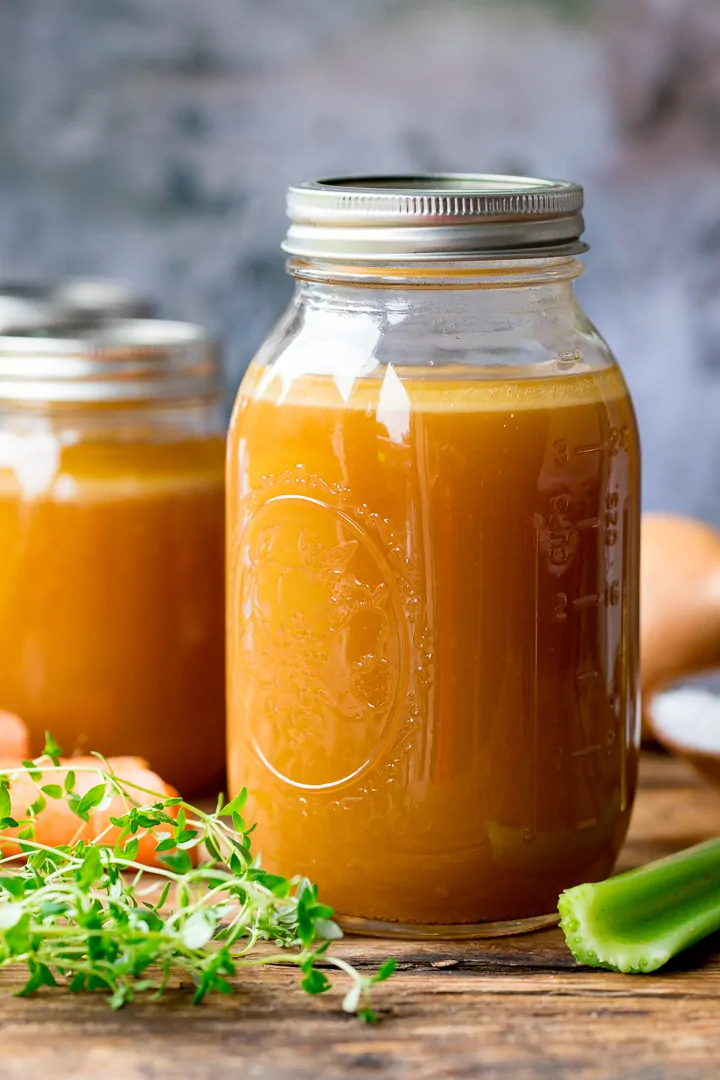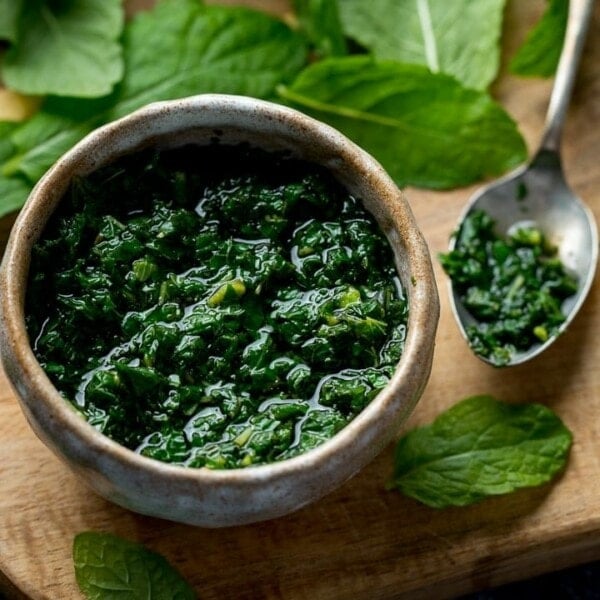Learn how to make rich and flavourful chicken stock. Five minutes of upfront work, then leave it to simmer away. A staple recipe for the best soups, sauces and stews.

It’s standard practice in our house. Almost automatic.
Whenever we roast a chicken, the leftover bones are used to make stock.
If we haven’t got time to boil up the broth right then, the chicken carcass goes in the freezer, and is boiled up at the next opportunity.
With just the tiniest amount of effort, it means we’ve also got a soup or sauce base right there in the freezer (I’ve got 4 bags of stock in the freezer right now).
Does that mean I don’t use stock cubes?
Heck no! I love those little foil covered oxo cubes. But I use those to either make my stock or gravy stretch further (without the flavour being watered down), or crumbled in to add a bit of extra flavour to certain recipes too (like spaghetti bolognese or chilli con carne).
Stock cubes are great, but they’re a flavour helper. Homemade stock on the other hand? You just can’t get that perfect homemade taste from a packet or jar. We’re here for the real thing!
So here’s my guide on how to make stock.

First take your cooked chicken carcass and remove any shreds of meat (we can freeze these to add to chicken soup or fried rice later). Place in a large sauce pan along with a carrot, stick of celery and an onion (all sliced in half, no need to peel) and completely cover with water.
Add salt and pepper, bring to the boil and simmer for 4-5 hours until reduced by three-quarters.
Turn off the heat and carefully strain into a jug over a fine mesh sieve. Be sure to push down the veggies and bones to get the most liquid out. Discard the solids left in the sieve.

Storing homemade chicken stock:
Refrigerating homemade stock:
Cool the stock and place into a clean container (such as a mason jar). Place a lid on top and refrigerate. It will keep in the fridge for 3-4 days.
Freezing homemade stock:
Cool the stock and transfer to a clean contain (remember, liquid will expand when frozen, so use a plastic container, not a glass one) and place a lid on. Or transfer to a freezer bag and seal. They should keep in the freezer for 6 months.
Defrost overnight in the refrigerator (if you froze it in a bag, then place the bag in a jug in the refrigerator to defrost).
Top tips for making homemade stock:
- Pull as much meat off the carcass as you can before you boil it. The flavour of the stock mostly comes from the bones, and all of the solids will be discarded, so any meat left on will end up being thrown away. Instead save the shredded meat. It’s great for adding to chicken soup (that you can make with your broth), salads, ristotto or fried rice.
- Make the stock go further. If I’m short on stock, I’ll add a crumbled stock cube and a cup (240ml) of water to my stock. This helps to stretch it out, but you still get that homemade flavour.
- Don’t have time to boil up the carcass right away? Place in a clean bag or wrap the carcass tightly in parchment and then foil (after removing the scraps of meat and storing them separately) and freeze. You can add the frozen carcass to the pan with the water and vegetables when you do have time to make make the stock.
- More than one carcass? Use a bigger pan and double or triple the recipe! If you have a chicken carcass ready to boil, and another one in the freezer, you can boil them up together (no need to thaw the frozen carcass).
- Want to use bones leftover from other meat (such as lamb or beef)? – make the stock in the same way. Lamb and beef have distinctive tastes, so be sure to label up the stock so you’re using the beef stock for beef dishes/gravies and the lamb for lamb dishes/gravies. Alternatively you can boil up multiple bones together for my three bone soup (using chicken, lamb and beef) -it’s delicious!!
- If you have fat on top of your chicken stock (even more likely if you’ve added any meat drippings from the roasting pan into your stock pot), then personally I would leave it there. The fat adds more flavour to the stock. However you can skim it off if you prefer. This is easier when the stock is cooked and sieved. If you refrigerate the stock, the fat will from a solid layer on top that can be scraped off.

Why is my chicken stock cloudy?
This recipe is a simple method for making chicken stock, and it will result in cloudy chicken stock, which is absolutely fine! It tastes delicious and is nutritious and flavourful. The stock is cloudy due to:
- The emulsification on fat in the water from the carcass – because we boil and simmer the stock
- We don’t skim the stock as it’s cooking (this is an easy hands-off stock)
- The added extras in the stock in addition to the carcass and water (i.e veggies and seasoning)
- The straining method – we’re only straining it over a sieve, not through a cheesecloth.
Sometimes people want a clear non-cloudy stock (for example for pho). There are methods for achieve this (such as blanching the bones, skimming the stock, not letting it boil etc (there’s a good article on Better Homes and Gardens for this).
Why is my refrigerated stock like jelly?
When it turns to jelly (jello) upon refrigerating, it means you have the best type of stock! The jelly is formed by the breakdown of collagen in the bones when you’re simmering the stock. It takes a good few hours (at least 4-5) for collagen to start to break down, but that’s where lots of the flavour comes from. You can add the jellified stock directly to the pan when you come to use it (as you would liquid stock), as it will turn back to liquid again within a few minutes of heating.

What’s the difference between chicken stock and bone broth?
They both start with the same process (adding the bones and vegetables), but bone broth is often simmered at a lower heat (barely any bubbling – you should see a bubble once every two or three minutes) for longer – anything from 12-48 hours. This releases more collagen and helps to break down the cartilage between the bones, so even more collagen can be released.
This results in a richer, thicker broth, which is delicious by itself as a warm drink, or can be used in place of stock
How to use it for soup
Add to these soups for the best tasting result:
More recipes that you can use your chicken stock with:
- Meaty gravy – use the stock in place of the stock cubes and vegetable cooking water
- Creamy Chicken and Mushroom one pan casserole
- One pot garlic chicken pasta with kale
- Chicken and Bacon Mac N Cheese
- White Chilli Chicken Con Carne
The Chicken Stock Video:
The Chicken Stock Recipe:

Chicken Stock Recipe
Ingredients
- 1 leftover chicken carcass
- 1 large carrot broked in half (no need to peel)
- 1 stick celery roughly broken
- 1 onion sliced in half (no need to peel)
- 1 tsp salt
- ½ tsp black pepper
- you can also add in any leftover drippings from the roasting pan if you have them optional
Instructions
- Place the chicken carcass, carrot, celery, and onion in a large pan and cover with cold water.1 leftover chicken carcass, 1 large carrot, 1 stick celery, 1 onion
- Add in the salt and pepper and bring to the boil.1 tsp salt, ½ tsp black pepper
- Turn down the heat and simmer for 4-5 hours until reduced by three-quarters.you can also add in any leftover drippings from the roasting pan if you have them
- Turn off the heat and allow to cool for 10 minutes, then place a fine sieve over a jug. Pour the contents of the pan into the sieve, squeezing any juices out with the back of a spoon.
- Pour the stock into clean jars, place a lid on a refrigerated (will keep for 3-4 days)
- Or cool completely and transfer to a freezer bag or freezer safe tub with a lid and freeze.
Video
Notes
Refrigerating homemade stock:
Cool the stock and place into a clean container (such as a mason jar). Place a lid on top and refrigerate. It will keep in the fridge for 3-4 days.Freezing homemade stock:
Cool the stock and transfer it to a clean container (remember, liquid will expand when frozen, so use a plastic container, not a glass one) and place a lid on. Or transfer to a freezer bag and seal. They should keep in the freezer for 6 months.Defrost overnight in the refrigerator (if you froze it in a bag, then place the bag in a jug in the refrigerator to defrost). Got leftover drippings? You can add any excess drippings into the pan at any time during the simmering process. If you like, you can strain off any excess fat from the drippings first, but a little fat will add extra flavour.
Nutritional Information:
Nutritional information is extremely difficult to work out for this as the automatic calorie counter takes into account the vegetables used - even though we discard them at the end.The size and amount of fat left on the chicken carcass my also differ. So please take this as a rough guide. Also, if you add the meat drippings and oils from the roasting tray there will be more calories and fat (there are approx 120 calories and 14g of fat in oil).
Nutrition
Nutrition information is automatically calculated, so should only be used as an approximation.
Some of the links in this post may be affiliate links – which means if you buy the product I get a small commission (at no extra cost to you). If you do buy, then thank you! That’s what helps us to keep Kitchen Sanctuary running. The nutritional information provided is approximate and can vary depending on several factors. For more information please see our Terms & Conditions.


















This recipe has been my go-to since I started getting serious about homemade staples! Its simple to throw together and I love the rich color that results. One extra thing I add is 3-6 chicken feet to add more collagen and amino acids to the stock.
Thank you so much for posting!
Hi Nicky,
Just wondering if you freeze your stock in specific amounts or the whole batch in one.
Thanks
Sarah
I like to freeze my stock in ice cube trays and then pop out and keep in a sandwich bag in the freezer. I can then add them to everything I make with ease as don’t have to defrost.
Hi Nicky,
I was just wondering if I could do this in a slow cooker set on low overnight? And is this something you have tried?
Kind Regards
Sandra
Hi Sandra, I haven’t tried this (great idea though – i’ll definitely give it a go).
My suggestion would bring to the boil, then cook on low in the slow cooker for 8-10 hours.